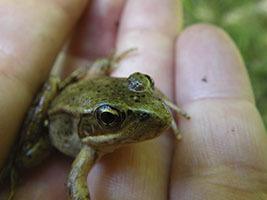By Russel Barsh and Madrona Murphy
Something is killing the world’s frogs and other amphibians, and some biologists regard the plague as the greatest ecological disaster since a small asteroid struck the earth roughly 65 million years ago – something thousands of times larger than the Chelyabinsk meteor that exploded over south central Russia earlier this year.
The apparent cause of death is a species of chytrid fungus with the impossible name Batrachochytrium dendrobatidis, first identified in 1998. Roughly one third of all species of frogs and salamanders worldwide have already been affected. Some suffered almost total mortality, while others survived periodic epidemics.
Chytrids are very ancient, at the base of the fungal and animal lineages, so they share some characteristics with protozoa and multicellular animals. They have gametes that swim, for example, just like sperm in animals. Chytrids tend to be parasites that live on other organisms. Most of the thousand known chytrid species live in fresh water, but some are marine, and others form mycelia in soil just like “modern” fungi.
Chytrids cause visible discolored skin lesions and scabs in amphibians, interfering with the animals’ ability to absorb oxygen and maintain water balance. Infected animals become disoriented, lethargic and do not avoid predators.
However, the rapid spread and unusually high mortality of the fungus suggests additional factors are involved that have stressed amphibians, compromised their immune systems, and made them more vulnerable to infection.
Candidates for stressors include the ozone “hole” and increased UV radiation; industrial chemical soup; habitat loss; …
Equally unclear whether it is a “new” organism, or one that has co-existed for millennia with amphibians but only recently has grown more lethal. The disease was first observed as early as the 1970s and was recognized globally in the last 15 years, but may have existed earlier in a less virulent form.
It may have been spread by widespread laboratory use of the African clawed frog xenopus. Not only xenopus but American bullfrogs and tree/chorus frogs are relatively tolerant of the fungus and therefore can function as carriers.
Western Washington’s native amphibians have been declining rapidly over the last 25 years. Here in the islands, western toads have nearly disappeared, our two true salamanders are scarce, and red-legged frogs are reduced. Only bullfrogs are thriving. It has been assumed that expanding bullfrog populations were eating their amphibious cousins into extinction in the islands, but the possibility of chytrid infection, possibly introduced by bullfrogs, has not been investigated.
At the same time, no systematic surveys have been conducted to identify critical reproductive habitat for the islands’ amphibians. Toads and salamanders depend on a relatively small number of home ponds, like the maternity roosts of bats and spawning gravels of salmon. Loss of a home pond can result in loss of all toads or salamanders over an area of several square miles. By contrast chorus frogs, bullfrogs and rough-skinned newts are more widely dispersed and form much smaller reproductive groups.
Significantly, the amphibians that appear to be in most trouble in the islands are the ones that rely on a small number of home ponds, most notably the toads. Red-legged frogs form a middle category. They tend to be associated with moving water, and there are few perennial streams in the islands – fewer every year, as dams and ponds continue to reduce stream flows. But they form many small groups, even within a watershed.
Nothing is simple in ecosystems. Amphibians that rely on home ponds are more vulnerable to contagious diseases because they come together in much larger numbers—like cities. Those that reproduce in smaller groups or, like chorus frogs, individuals, are less likely to transmit contagious pathogens like Chytrids to other members of their own species, or other species that share the same bodies of water.
If you are interested in supporting amphibian conservation in the islands by conducting surveys or contributing to chytrid screening, contact kwiaht@gmail.com.





